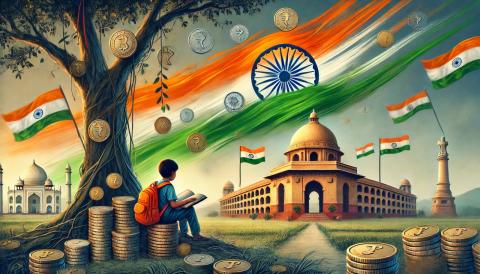
Celebrating the Republic: Let’s Prioritize Education for Every Child
Last year, I received a call from a student from my village. He happily shared that he had secured admission to a reputed private university in Bhopal and received a 75% fee waiver. However, he still needed to arrange around 1.5 lakh rupees for hostel and tuition fees. His excitement about getting admission was mixed with anxiety about arranging the remaining amount. I couldn’t promise to help him with his fees. A couple of months later, when I visited my village, I met him again and was disappointed to learn that he couldn’t arrange the fee, and as a result, his admission was canceled.
This is not an isolated incident. One of the biggest disappointments I face when working with government school students is that most of them do not pursue higher education. Their lack of capability is not the reason—it is the unaffordability of higher education. Unfortunately, the UGC does not maintain data to indicate the percentage of students from government schools who continue their higher education in regular mode. While we lack precise data, empirical evidence suggests it is less than 5%. This means that out of 100 students who studied in government schools, only 5 in the age group of 18-23 continue higher education in regular mode after grade 12. The national average, however, is around 28%.
This data reflects how India perpetuates its class structures by depriving a large number of children of the opportunity to enter institutions of higher education. While 1 lakh rupees as an annual fee might seem modest from a privileged perspective, consider this: 850 million people in India rely on subsidized rations provided by the government. A report by the Institute for Competitiveness reveals that only 10% of Indians earn more than Rs. 25,000 per month. Imagine the plight of students from households where the monthly income is less than Rs. 2,500—1 lakh rupees as an annual fee becomes an extravagant amount.
Every year, teachers in schools collect money from their personal savings to pay the CBSE fee of around Rs. 2,500 for grade 12 board exams for some students. Many of these children can continue their education up to grade 12 because schools are available in their neighborhoods and government schools do not charge any fees. However, both of these provisions vanish after grade 12. Colleges are not located in close proximity, and they charge significant amounts annually for tuition and other expenses.
As a result, millions of aspiring students are forced to stay out of the ambit of higher education and lose the opportunity for social and economic mobility.
On this Republic Day, I wonder: can our governments at least ensure that no student is deprived of access to higher education due to financial constraints? On one hand, the National Education Policy (NEP) 2020 aims to increase enrollment in higher education to 50% by 2035. On the other hand, governments are finding ways to cut expenditures on higher education. Aren’t these two goals contradictory?
If we fail to prioritize education even after 75 years of being a republic, I have no hesitation in saying that our priorities are misplaced. Everything else can wait, but not education.
- Log in to post comments
